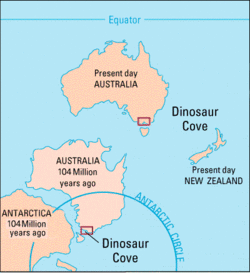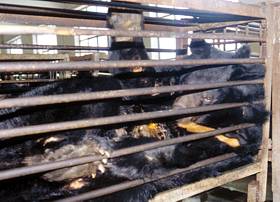 ( picture :http://pubs.usgs.gov/publications/text/cove.html)
( picture :http://pubs.usgs.gov/publications/text/cove.html)
The Chocolate Mammal
Dinosaur Cove is a dinosaur bone digging site in southern state of Victoria, Australia. Fossils from this site have provided excellent insight into dinosaur habitats. In the early Cretaceous period, Australia was in a much more southern position than it is now, and was joined to Antarctica. Dinosaur Cove has yielded fossils that provide us glimpses of how the dinosaurs managed under cold conditions. At least three dinosaur species have been discovered in Dinosaur Cove which have been referred to as the polar dinosaurs of Australia. The name polar given to these mammals, though snappy, is not entirely correct, as during the Cretaceous period, the average temperature of the earth was higher than it is now, so the polar regions would have been more habitable than they are today. Even then, it has been estimated that it would have been somewhere in the range of -6 to 3 degrees centigrade.
Actually, this was one of the places where some dinosaurs were still living as relics (literally as “living fossils”) when they had died out in other parts of the world. And it seemed Dinosaur Cove had been a favorable place nearly 100 million years ago. But such discoveries at the site have forced scientists to seriously rethink about dinosaur habitats, though the first idea of a polar dinosaur cropped up in 1960, when dinosaur footprints were found on the island of Spitsbergen, which lies between the sea separating Norway and Greenland, rather close to the arctic circle.
Dr. Thomas Rich, has been the Curator of Vertebrate Paleontology at the Museum Victoria since 1974, and has led digging at Dinosaur Cove from 1984 to 1994, by this time the site had been “dug-out” in paleontology parlance. The site had yielded a large number of bones, and many were labeled and stored without thorough examination, biding their time.
Back in 1987, bone digging volunteers dug away dreaming of unearthing dino jaws and staking claim to one kilogram of chocolate, which was offered up by Dr. Rich to enthuse them to keep chipping away. A dinosaur jaw was eventually found by a student, who managed to consume the trophy (the chocolate, not the jaw) all by herself. However, evidence of mammals intermingling with dinosaurs in Australia was a much bigger fish, and no one in the dig had unearthed such booty so far, considering the high price set by Rich, a ridiculous amount of chocolate no one could hope to ever finish, one ton.
Yes, Rich, being extremely skeptical at that time, humorously promised anyone who pulled a mammalian bone from this dinosaur joint a ton of chocolate, no questions asked. A bone labeled “humerus? turtle?” was found one day by Dr. Rich himself in the lab. Looking over intriguingly at the label and the bone and recognizing that it didn’t seem to be a turtle bone, he decided it was time to send it to experts on ancient mammals. They confirmed that indeed it was not a turtle humerus, but one from an animal related to the spiny anteaters (echidna).
The echidna is an unusual mammal, which lays eggs and suckles its young, and like the platypus, belongs to the monotreme group of mammals. Echidnas are slow moving, hairy creatures, equipped with a long sticky tongue, and a sharp spur on the ankle of the hind leg. They are also toothless, and feed almost exclusively on ants and termites, which they obtain by breaking their nests or mounds and helping themselved with their tongue. They are commonly seen in Australia, New Guinea and Tasmania.
Dr. Rich was understandably thrilled to have discovered such a rare bone, but the crisis of providing one tone of chocolate also reared up.
A volunteer during the dig offered to help as she had known a boy whose father ran the Cadbury factory in Melbourne. As it is almost impossible to create a one ton bar of chocolate, the factory agreed to make a one-cubic meter bar of cocoa butter, the basis of all chocolate.
As there was no way to ascertain which volunteer had actually found that particular bone, Rich invited all the volunteers to a chocolate party at the factory.
The new mammalian species was named Kryoryctes cadburyi. Kryocytes meaning cold digger, as it was well adapted to living and digging for food in the cold), and cadburyi, meaning well, I’m sure you understand.


